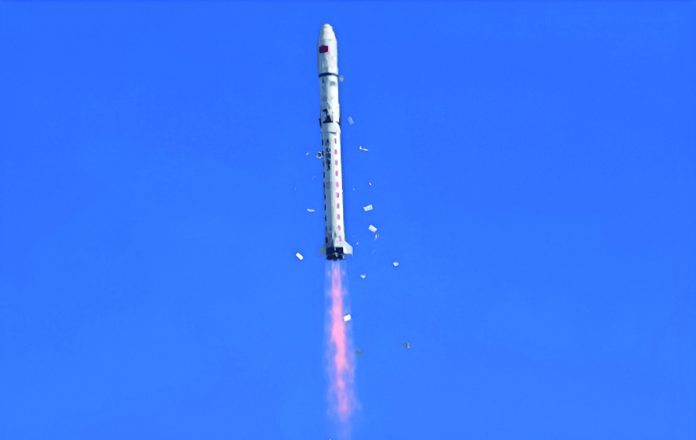Syed Samiullah
On January 17, 2025, Pakistan achieved a monumental milestone in its journey towards self-reliance and technological excellence by successfully launching its first indigenous observation satellite, PRSC-EO1 (Pakistan Remote Sensing Satellite – Earth Observation 1). The launch took place at the Jiuquan Satellite Launch Centre in northern China aboard a Long March-2D carrier rocket. The Space and Upper Atmosphere Research Commission (SUPARCO) spearheaded the project, highlighting Pakistan’s growing expertise in space science and technology. Prime Minister Shehbaz Sharif congratulated the nation, including the scientists and engineers, on the satellite’s successful launch. “Congratulations to our scientists and engineers for their dedication and great team effort!” he said. The prime minister also commended SUPARCO’s efforts, emphasizing that the successful launch demonstrated Pakistan’s advancing capabilities in space science and technology.
Significance of PRSC-EO1
PRSC-EO1 represents a significant step forward in Pakistan’s aspirations to leverage space technology for national progress and sustainable development. The satellite is equipped with electro-optical sensors designed to capture high-resolution data and images of the Earth’s surface by detecting and measuring reflected sunlight or emitted radiation. This data plays a crucial role in applications such as agriculture, urban planning, disaster management, and natural resource monitoring. The satellite also enhances Pakistan’s strategic and scientific standing within the global space community. The Inter-Services Public Relations (ISPR) described it as a “momentous milestone.”
“Today’s achievement positions advanced space technology capabilities at the forefront of Pakistan’s national progress and development, in alignment with the objectives of the National Space Policy,” stated Deputy Prime Minister and Foreign Minister Senator Mohammad Ishaq Dar.
Applications of EO-1
The PRSC-EO1 satellite is a game-changer for various sectors in Pakistan. Its applications are diverse and promise to drive significant socio-economic benefits:
- Agriculture
EO-1 plays a pivotal role in agriculture by enabling precision farming through precise monitoring of crop health and identifying areas needing attention, such as irrigation or pest control. Its advanced imaging capabilities assist in optimizing water use by analyzing soil moisture levels, thereby enhancing irrigation management. Additionally, the satellite facilitates accurate crop yield predictions, aiding in effective food security planning and minimizing wastage.
- Urban Planning
In the realm of urban planning, the satellite plays a vital role by enabling the monitoring of infrastructure growth and urban expansion, providing policymakers with essential data to track and manage development effectively. Additionally, it aids in controlling unplanned urban sprawl by delivering updated geographical information, ensuring better planning and sustainable urban growth.
- Disaster Management
EO-1 plays a crucial role in disaster management by providing timely updates during floods to improve response times and minimize losses, assisting in identifying affected areas during earthquakes and landslides for efficient rescue operations, and monitoring deforestation trends and land degradation to support environmental conservation efforts.
- Environmental Monitoring
The satellite also plays a pivotal role in environmental and resource management by tracking glacier recession, which is vital for safeguarding Pakistan’s water resources, providing detailed imaging to support efficient management of rivers, lakes, and reservoirs, and aiding in the exploration and conservation of minerals, oil, and gas reserves.
Technical aspects of EO-1
PRSC-EO1 is a state-of-the-art satellite built using advanced electro-optical technology. Its imaging sensors are capable of detecting radiation in both visible and infrared spectra, allowing it to capture high-resolution images of the Earth’s surface. These images are crucial for:
- Geospatial analysis
- Environmental impact assessments
- Infrastructure mapping
Collaboration with china
Pakistan’s longstanding space collaboration with China has been pivotal to the success of its space program. The Long March-2D carrier rocket that launched PRSC-EO1 also carried two other Chinese satellitesTianlu-1 and Blue Carbon 1into orbit. This mission highlights the robust technological partnership between Islamabad and Beijing, often described as being “higher than the Himalayas and deeper than the oceans.” China’s contribution to Pakistan’s space drives includes previous launches of communication satellites like PakSat-MM1 and lunar exploration projects such as ICUBE-Qamar, a joint venture between SUPARCO and Shanghai Jiao Tong University. These collaborations reflect the growing aerospace ties between the two nations.
Economic impact
The Earth observation satellite market, currently valued at $5 billion, is one of the fastest-growing sectors in the space industry. Analysts predict this market will surpass $8 billion by 2033. With the launch of PRSC-EO1, Pakistan positions itself to leverage this booming market for both economic and technological gains.
- E-Governance:EO-1 will enhance the efficiency of government services through improved data collection and analysis.
- E-commerce and Broadband: Coupled with satellites like PakSat-MM1, EO-1 contributes to the digital transformation of Pakistan, improving connectivity and promoting economic activities.
Conclusion
As global powers like the US, China, and India expand their satellite networks, Pakistan’s launch of PRSC-EO1 marks its entry into the competitive space arena. By leveraging this technology, Pakistan aims to narrow the gap with leading nations and achieve self-reliance in critical areas. The EO-1 satellite highlights Pakistan’s commitment to space exploration and showcases the role of science and technology in driving national progress while inspiring future generations.
The author is the Head of Research Department at RFI and the Associate Editor of Monthly Interaction.







